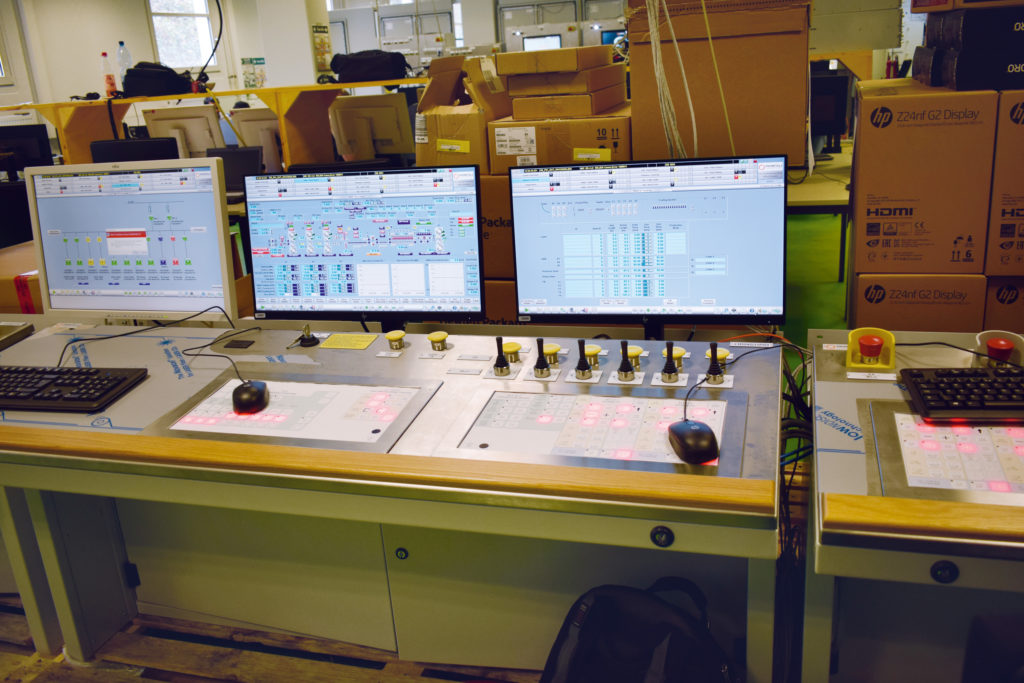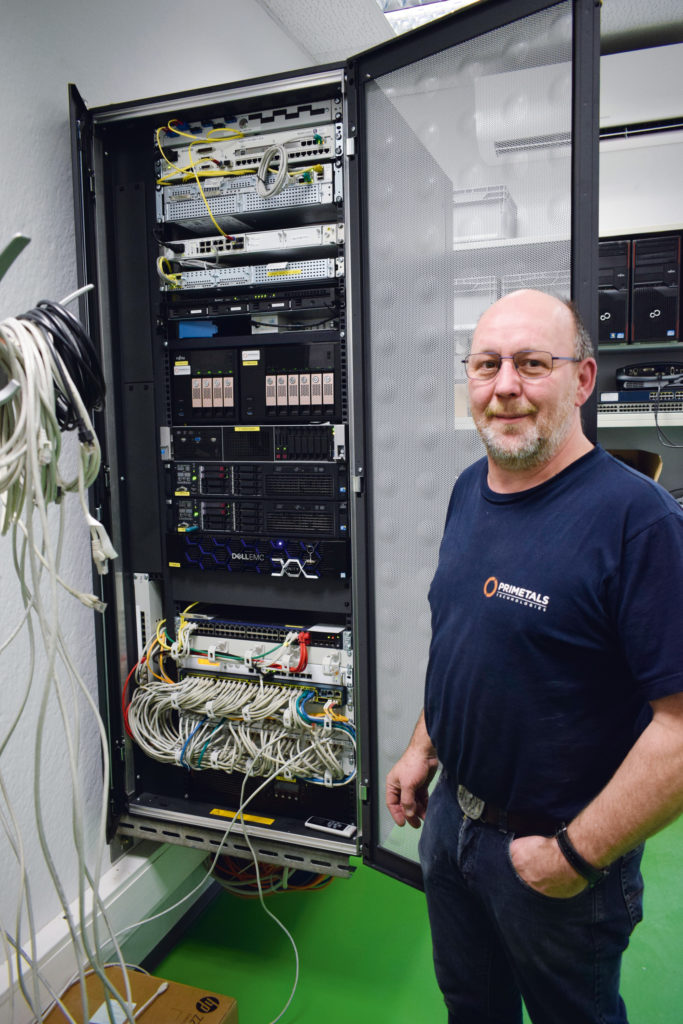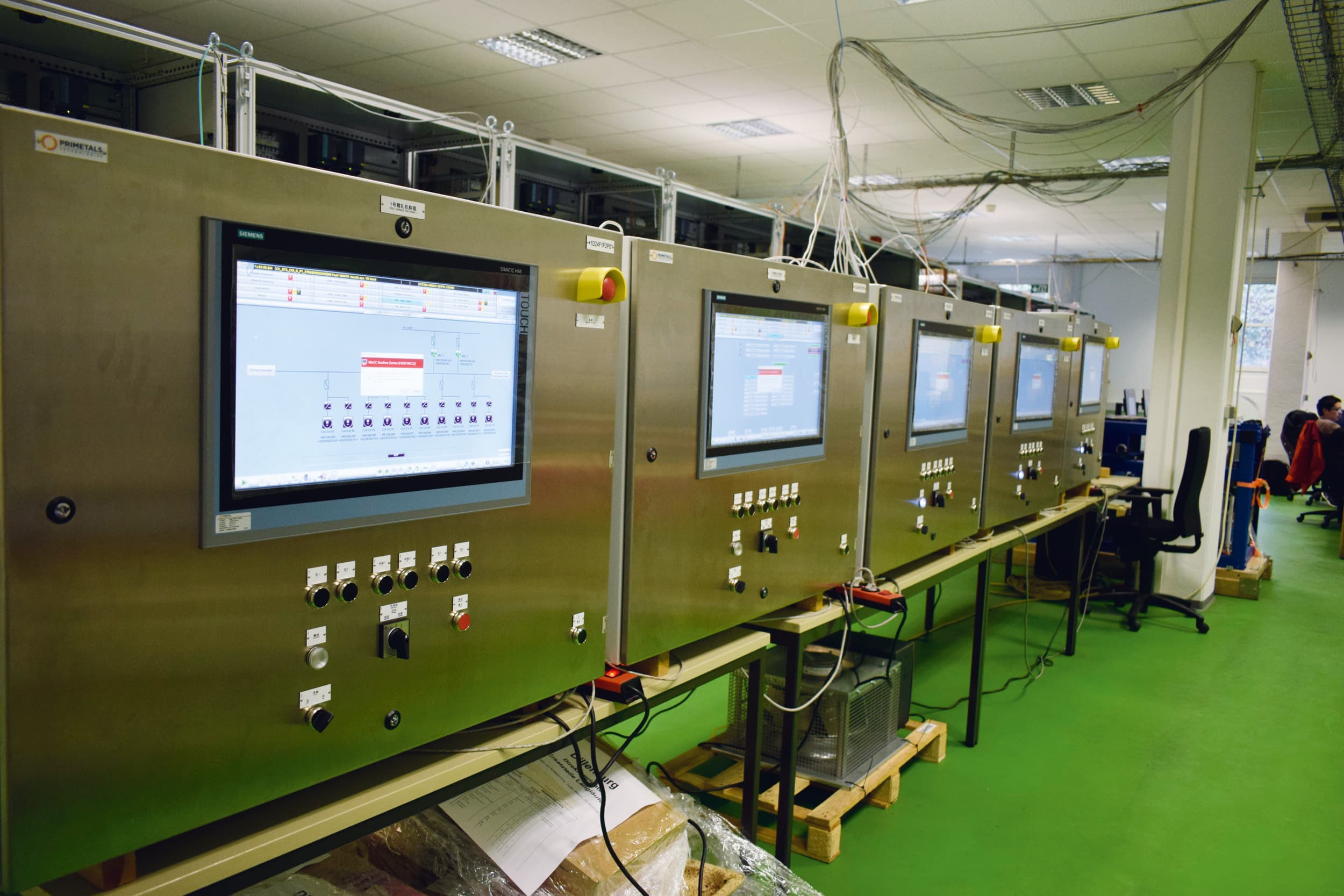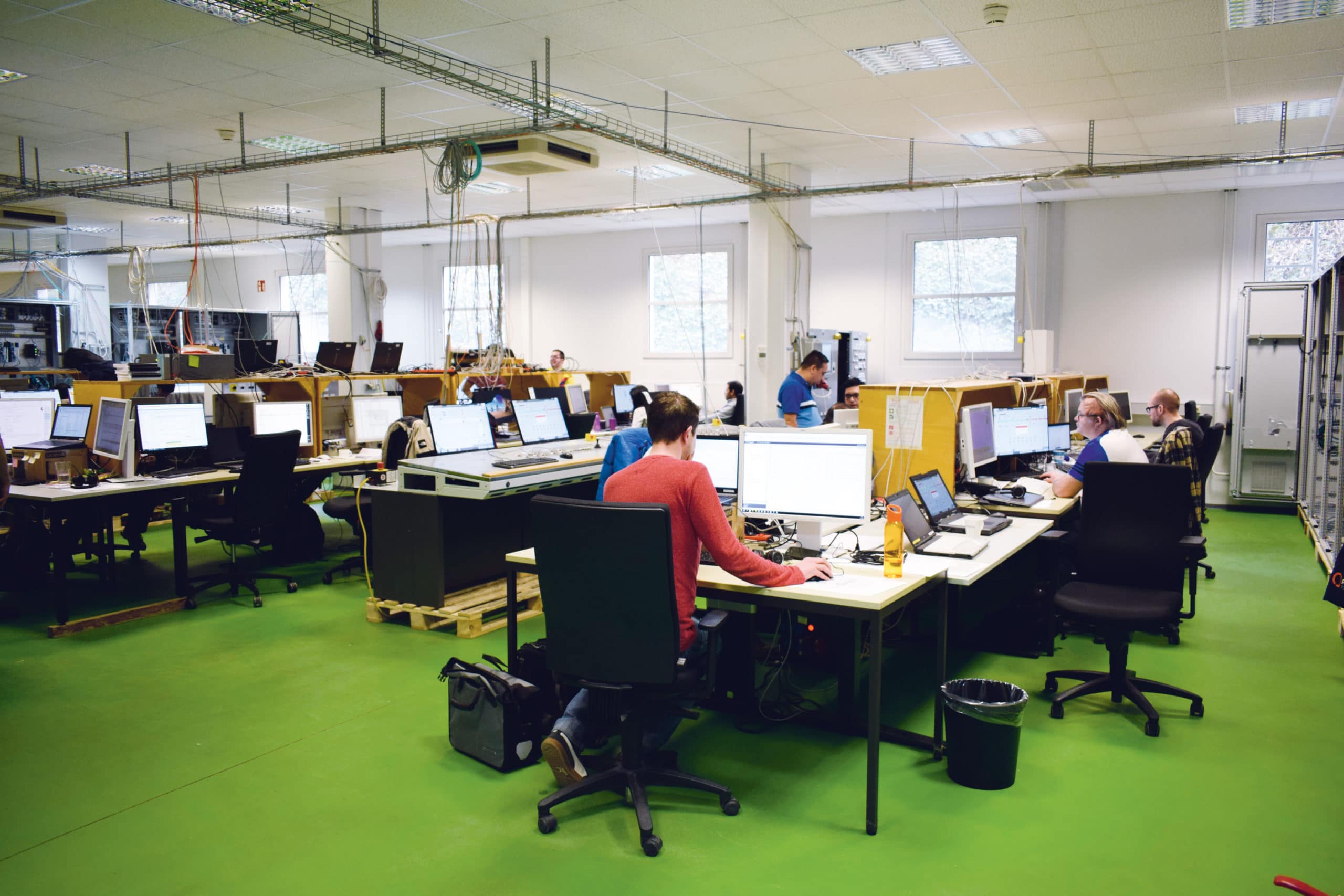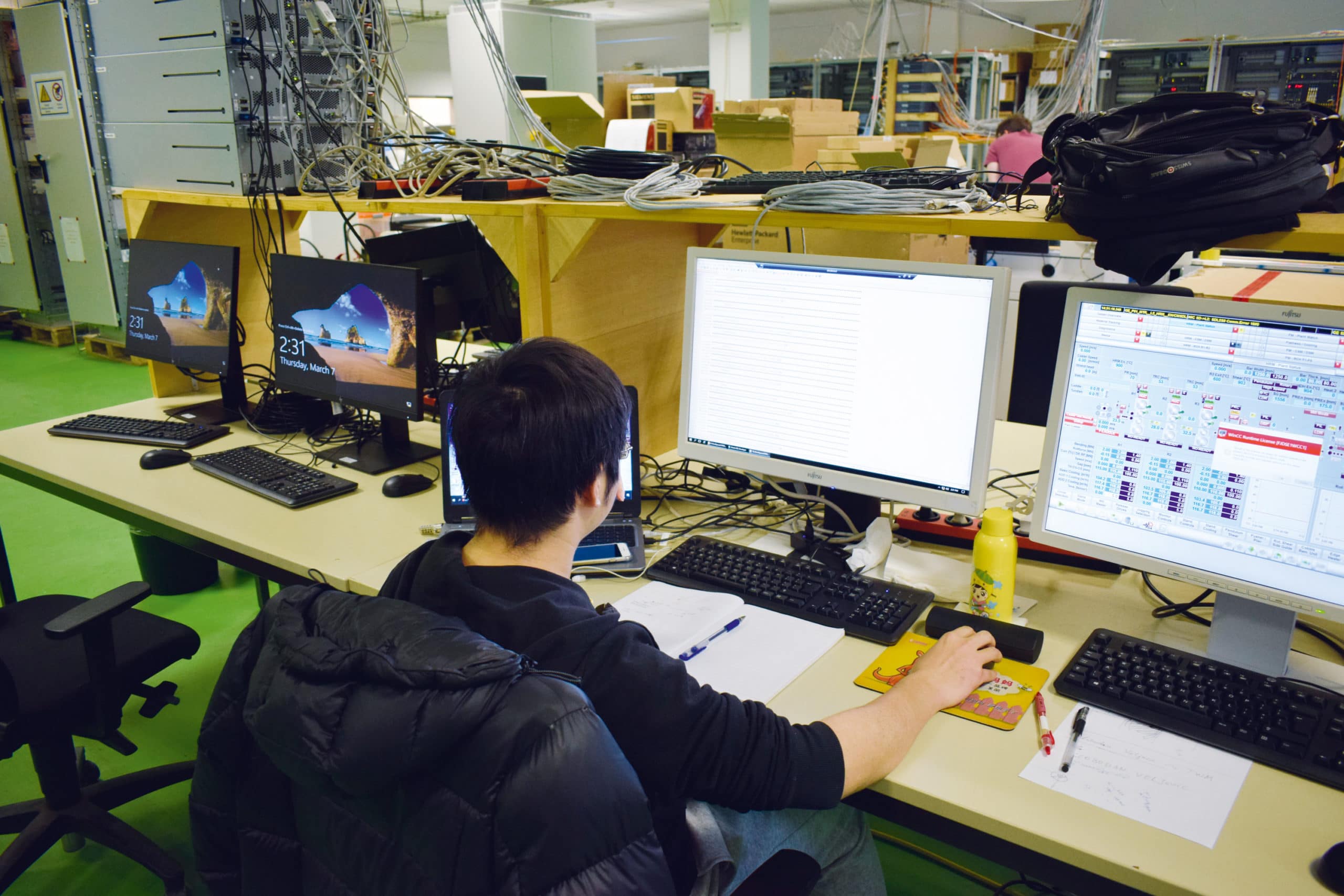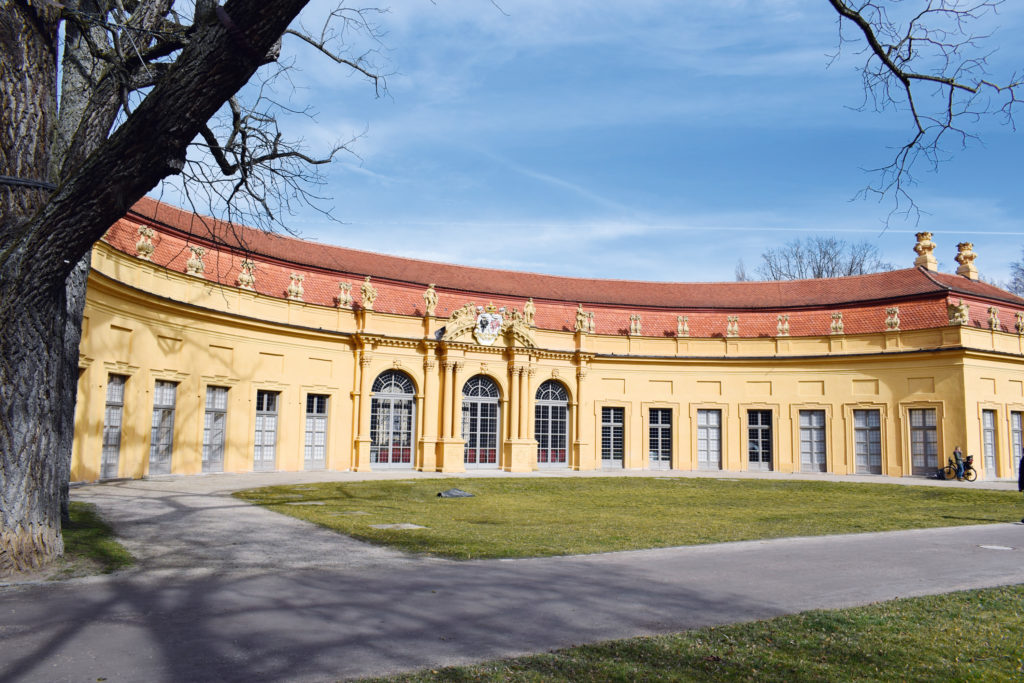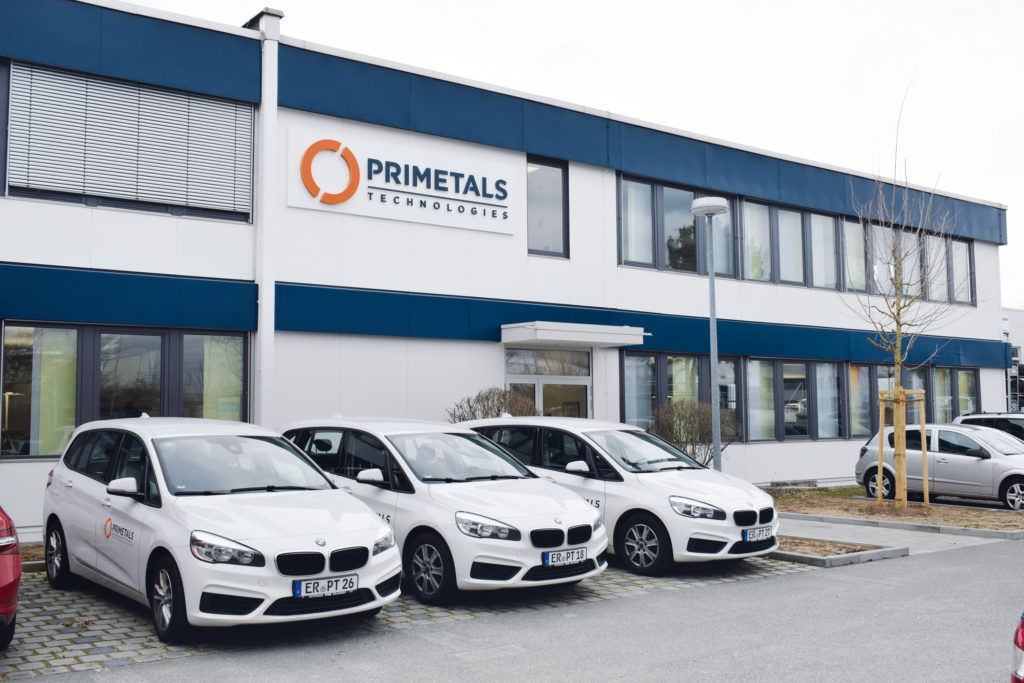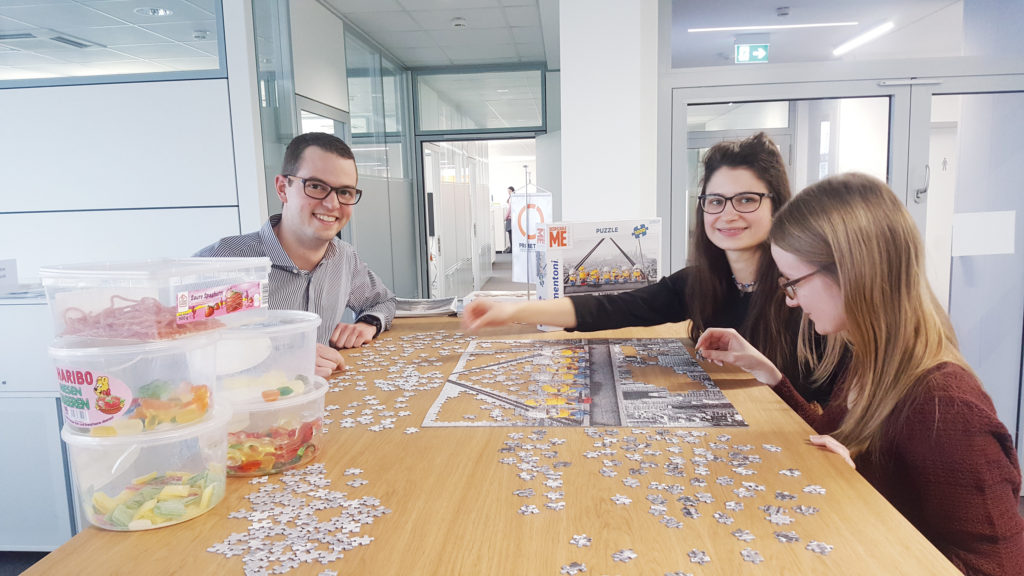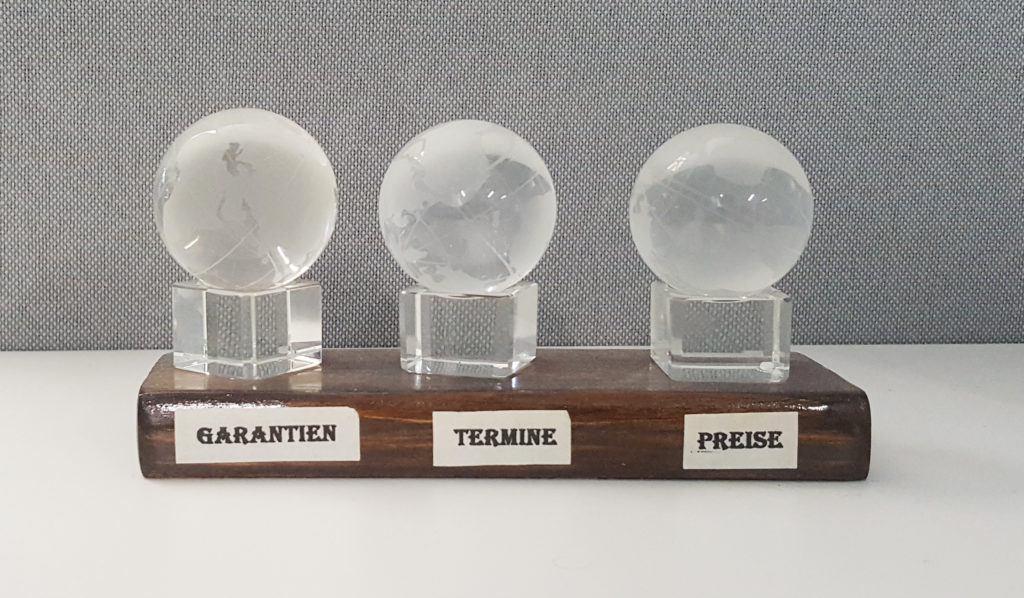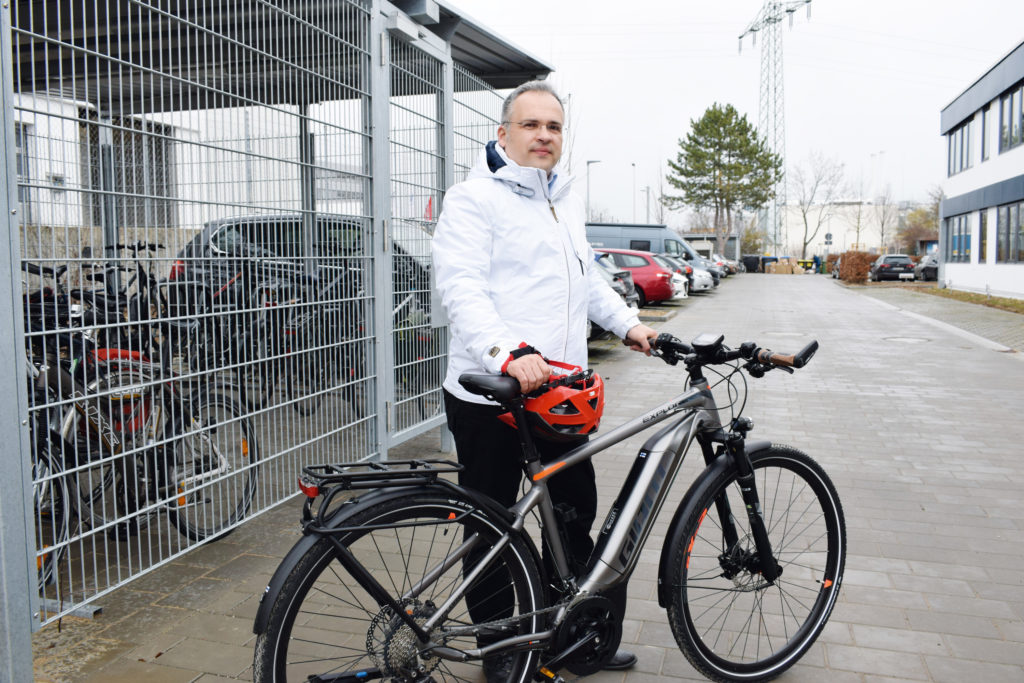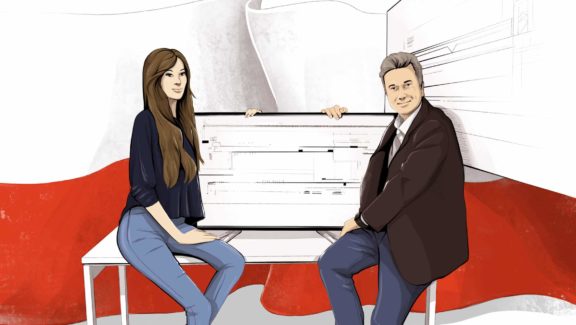This post is also available in: 简体中文 (Chinese (Simplified))
In German, “Weltmeister” means “world champion,” and Germany has indeed accumulated many such titles over the years—be it in football or thanks to its strong, export-oriented economy (“Exportweltmeister”). The technology specialists at the Erlangen location of Primetals Technologies are equally world-class: they excel at developing new, Industry 4.0 compatible electrics and automation solutions for steel producers around the world. Metals Magazine’s Dr. Tom Widter visited the location.
As I approach the main entrance of Primetals Technologies Erlangen’s new office building, the front door swings open automatically, inviting me to step inside. It is not a sliding door, which you’d expect to be motorized, but an utterly massive construction made out of glass and steel, and equipped with enormous handles on both sides. With impeccable timing it opens up toward me, subtlety hinting at the fact that this is a place where everything is automated to perfection.
I am welcomed by Katharina Landes, in charge of communications at the location. “If you’re impressed by our doors, you’ll be thrilled with our conference rooms,” she says. Indeed, next to every conference room, there’s a cutting-edge touch panel that allows you to directly book meetings, and every action is synchronized with everyone’s Outlook calendar and the central facility-management system. All the light switches are digital, and the lights themselves are of the new-style LED type that I have not yet seen before.
But of course, these are just gimmicks compared to the sophistication it takes to automate steel plants. The technologists in Erlangen specialize in electrics and automation for the downstream area—everything related to rolling and processing—, and they collaborate with other company locations to deliver endless casting and rolling solutions such as Arvedi ESP. While they certainly have the expertise to plan and execute the implementation of advanced automation systems for any greenfield plant, their main focus is on upgrade packages and modernization concepts for existing production facilities.
A city of students and Siemens
The Erlangen location has its roots in Siemens, and while the staff have forged their own identity in the four years since Primetals Technologies was founded, the presence of Siemens can still be felt. Many Primetals Technologies employees have spent years, if not decades, working here, and with a workforce of more than 20,000 in Erlangen alone, the company’s presence in the city is inescapable. “Erlangen is essentially made up of Siemens people and the student community,” Landes tells me.
It shows. Many of the office buildings feature the Siemens logo, and with such a high student population there is a tendency for the inter-city commute to be made by bike—bicycles being the cheap and environmentally friendly means of transport that even the poorest of students can afford. You’ll find cyclists everywhere you look, even in winter.
The Erlangeners’ passion for biking, however, does not prevent them from loving their cars. On the contrary: sometimes it almost seems that, in Germany, patriotism is demonstrated only through an affection for German-made cars—and football. And with the Germans’ fondness for cars, you could argue, comes a natural affinity with one of the automobile industry’s most important base materials: steel.
The test center in Fürth
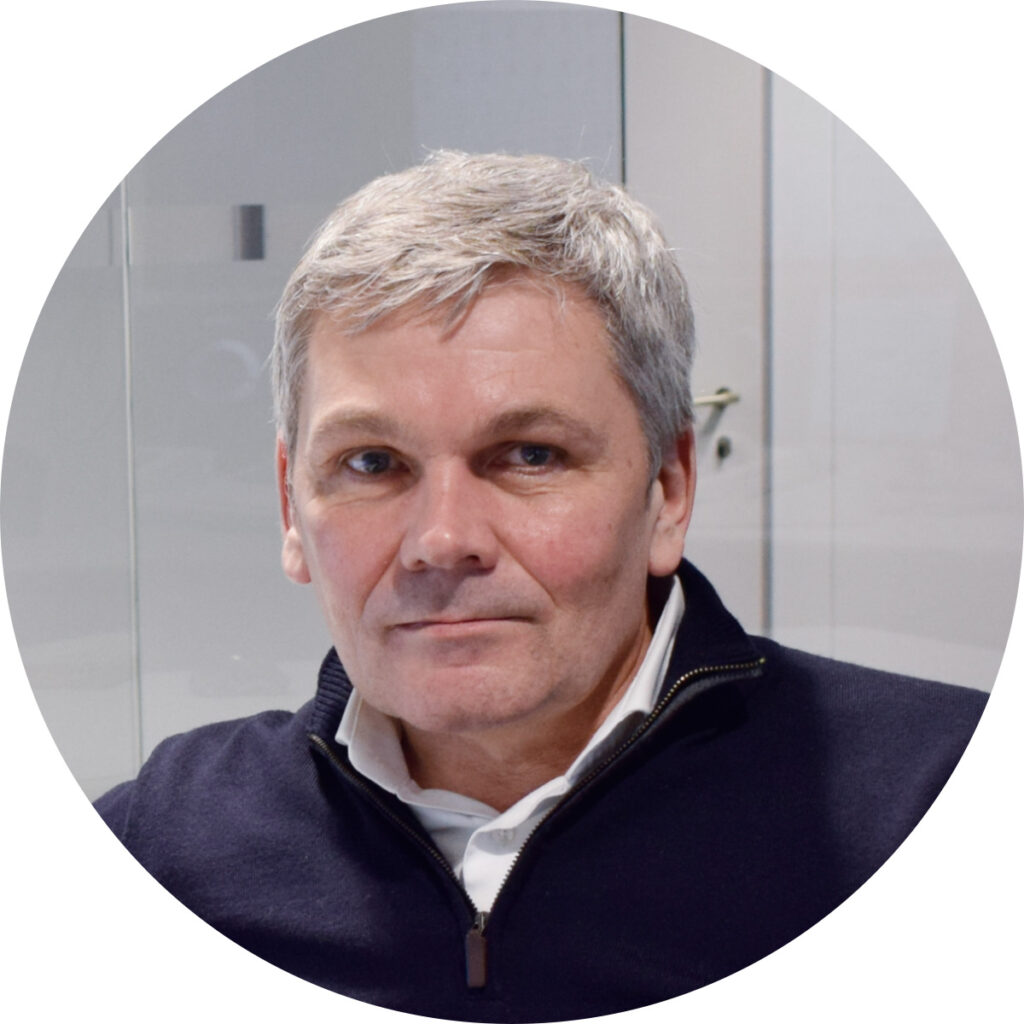
Interview with
Hubert Koebach
Hubert Koebach joined a predecessor company of Primetals Technologies in 1987 and is Head of Technology for the E&A downstream area.
Of all the technological achievements made in Erlangen, which are you most proud of?
Hubert Koebach: There are many achievements we can be proud of. To name just a few, we were the first in our industry to use neural nets to supplement our analytical process models. At that time, our approach was ridiculed by some, but things changed. Today, the view is that we did exceptional pioneering work, and everyone is talking about artificial intelligence and digital assistants. We were also early with pioneering “remote commissioning,” which allowed us to scale down the number of engineers on site and to better utilize our key experts supporting multiple sites via remote data connection. Nowadays, commissioning without a remote connection is unthinkable.
Is there an R&D project you are working on that you’re particularly excited about?
Koebach: We are working on programs to make our digitalized know-how in our solutions platform independent, and we are developing robust, self-optimizing, non-interacting multivariable controls to reduce tuning and commissioning time. We focus on R&D projects with fast ROI for our customers such as a second-generation condition-monitoring system including digitalized know-how modules helping our customer towards higher productivity through improved equipment availability and up-time.
Experts in steel production
It is steel that the staff at Primetals Technologies Erlangen live and breathe, especially from the perspective of the “digital orchestration” of a plant’s production equipment. After all, it was the German government that coined the term “Industrie 4.0,” and over the last few years, digital production technologies have advanced significantly—not least thanks to the efforts being made in Erlangen. Much progress has been made of late, and the steel producers of today have developed a sense of urgency that digitalization is something they need to embrace right now in order to stay ahead of the curve.
“We have seen many steel producers refine their digitalization strategy,” says Hans-Jürgen Zeiher, Global Head of Electrics and Automation. “Everyone is busy determining what steps to take next, but the truth is that comprehensive digitalization takes time.” Not all producers are equally forthcoming about their strategic goals, he says: “European producers tend to keep their thoughts on digitalization more to themselves, whereas their Chinese counterparts tend to be more open.”
Asked what aspects of the Fourth Industrial Revolution he believes to be most relevant for the steel industry, Zeiher says that producers should be focusing on implementing just-in-time production as soon as possible. “If you are capable of combining ‘lot size 1’-style production with holistic, product-oriented quality control, you’re in a superb position even in a competitive market.” Are there any hidden challenges to digitalization, I ask Zeiher. “It is easy to forget that steel producers need to properly train their staff to make the transition,” he says. It is a notion I have heard before. In some cases, steel producers undergo a process that is nothing short of a cultural shift in order to harmonize their operations with the new technological possibilities.
Pioneering digitalization
It turns out that the technologists at Primetals Technologies Erlangen have discovered a fair number of hidden challenges involved in implementing digital solutions for steel producers around the world. “It’s a process of constant discovery,” says Günther Winter, Head of Innovation for Electrics and Automation. “Digitalization means something different to every single steel producer. Everyone is in a unique situation and has their own targets.” Winter has a clear idea of the role Primetals Technologies has to play in terms of supporting producers on their journey: “There is no ‘official guideline’ for how digitalization should best be applied to steel production. It is therefore our job to come up with strong concepts, develop the solutions required, and steer our customers into the future.”
Is there any one technology currently in development that Winter expects to make a particularly great impact upon its release? “We are working on a next-generation condition-monitoring system,” he says. “Earlier systems already incorporated a lot of expert knowledge, but our ambition is to create something that is both even more comprehensive and very user-friendly—an expert system for people who don’t have to be experts themselves to use it.” Knowledge transfer, he goes on, is a big issue for many producers: it has become increasingly difficult to replace experienced staff who leave the company—for instance, through retirement. Solutions such as Winter’s next-gen condition-monitoring system and Through-Process Optimization (see, “Exploring What’s Next“) alleviate this problem by capturing the operators’ knowledge and adding to it. At their core, they are designed to ensure optimal knowledge management.
Neural networks, then and now
This kind of expert knowledge is evident throughout the entire company location, and whenever you talk to any of the technologists. Dr. Klaus Weinzierl has been working with advanced algorithms for several decades, which makes him the perfect candidate to introduce a historical perspective and explain to me the difference between the “neural networks” of the 90s and “artificial intelligence,” which is so often talked about today. “There definitely has been a technological evolution,” he says, “but it’s not so much that the architecture of the algorithms we use today have changed, rather the algorithms themselves have become more complex.” It is necessary to understand the concept of “depth” in deep learning, he says. It is about layers, and the number of layers a system can handle.
While the neural networks have increased in complexity, it is often the hands-on experience of applying them to steel production that makes the difference in terms of their effectiveness. “In theory, you have to program neural networks to cover all of the aspects that could possibly influence the processes they are meant to control. But in practice, this is often impossible. What you’ll then want to do is introduce random values at distinct points, so that the neural net can be trained not to be disrupted by unexpected events.” As a writer, I am naturally bad with numbers and algorithms, but this is fascinating.
Weinzierl tells me that it’s important to know the process you’re trying to automate in great detail. He once implemented a neural net-based automation system for a Russian customer, but when it was fired up, something wasn’t working correctly. The situation must have been tense; was his algorithm flawed? As can be expected from a cooling-line expert, Weinzierl kept a cool head. It occurred to him that maybe there was still air in the hydraulic system, and indeed there was. Once the air was released, everything worked as planned. His algorithm was fine.
Ever-smarter algorithms
I try to quantify the degree to which “smart” systems have become more intelligent. Dr. Rüdiger Döll, who has worked in rolling mill automation for 22 years, makes a comparison to illustrate the development: “When we started to digitally monitor the crown of the strip, we had one static track and one scanning track, which gave us three to six values over strip length. Today, it is not uncommon for up to 500 tracks to provide us with up to one hundred values over strip length.” Listening to Döll, it seems that the exponential increase in computing power evident in our everyday lives also extends to the steel industry. “Sure,” he says, “with the much-improved sensor technology we have available today has come the ability to store much more data.” This development, he says, is the core enabler for what we now call machine learning.
With machine learning on the rise, it seems logical to think that older algorithms might become outdated or outclassed. The steel industry has long relied on physics-based and mathematical models, which in themselves have grown and matured—and since they are often the product of decades of expertise, they are still being relied upon. Will artificial intelligence one day replace these tried-and-tested models? “No,” says Döll. “Both approaches are still valid and will continue to coexist. In fact, they complement each other.”
In effect, their applications vary, he says. “To give you an example, in hot rolling, we are still calculating the roll gap using physics-based models,” Döll says, “and very successfully so. But the flow stress of the strip is something we predict via a data-driven approach, with neural networks.” Some things, Döll says, can’t be calculated from first principles, especially not in real time—and even if this were to become possible, the models would still be unable to account for what Döll calls “the day’s form” of the mill. These “unknowns” can only be handled with statistical methods—and with data analysis.
How is digitalization changing Germany?
Employees of Primetals Technologies share many passions, such as pioneering new solutions for their customers. But every location also has its own unique qualities. In this section, we catch a glimpse of what makes Germany so special.

Germany’s strength is a unique combination of ingenuity, precision, and comprehensive higher education. Digitalization is changing all three of these factors.”
Dr. Alexander Thekale
Head of Electrics & Automation Digital
Solutions, Technology Downstream
Digitalization is impacting our lives on many levels. Soon, I won’t even have to order shampoo anymore when the bottle is empty—my digital assistant will take care of that.”
Karola Gurrath
Development Engineer; Models, Concepts and Solutions


Not enough. Wireless broadband availability is quite fragmented, with good coverage in major cities but a subpar infrastructure in the more rural areas.”
Dr. Rainer Schulze
Press Officer, Corporate Communications
Germany will become even more competitive. I recently read that several companies are bringing back manufacturing thanks to the advanced automation systems we’re embracing here.”
Andreas Maierhofer
Innovation Manager, Electrics & Automation
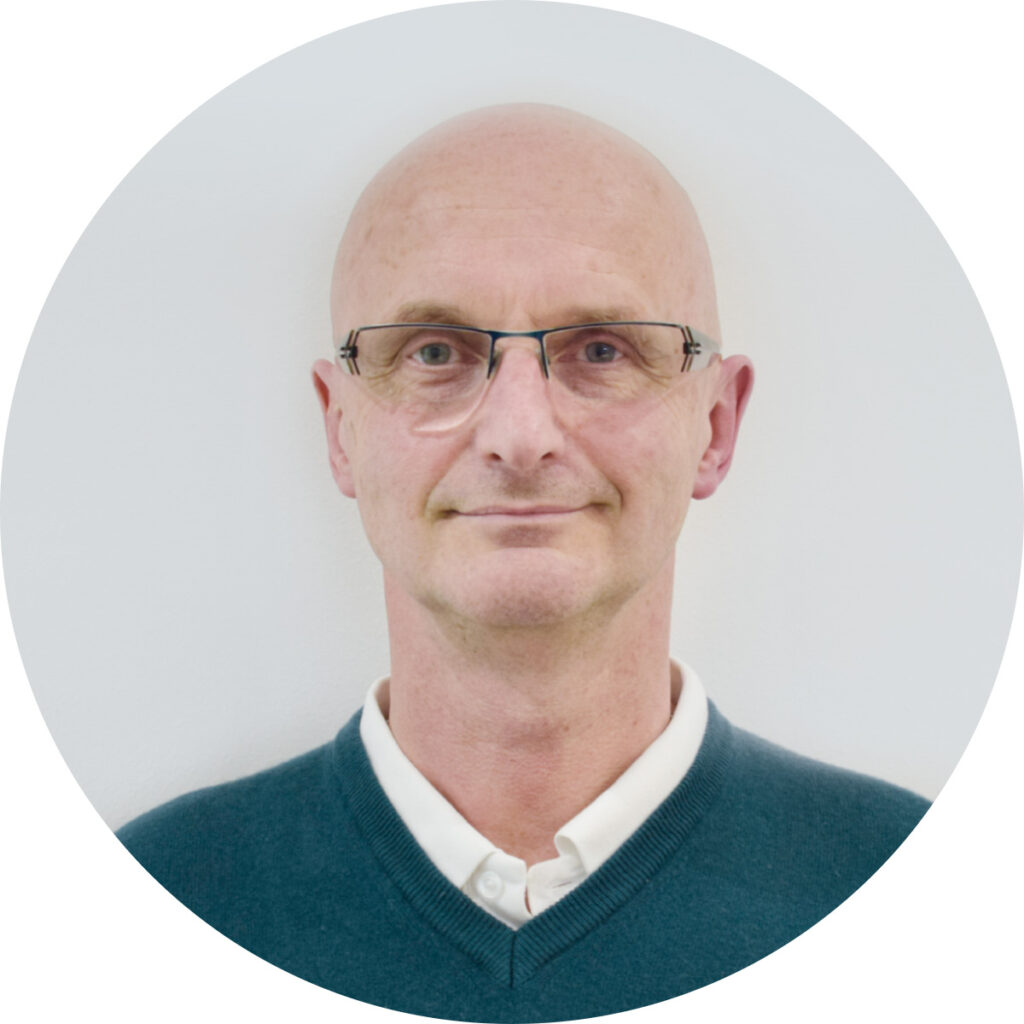

Our public transport system has seen a major transformation. You can plan your journey using smartphone apps, and in Nuremberg they recently introduced a driverless U-Bahn (the German subway train).”
Volkmar Stach
Service Manager, Process Automation
Coding with precision
Talking to the technologists in Erlangen is so intriguing that I almost wish I were a programmer myself. But it also makes me wonder how all these algorithms, all this expertise in plant automation, is applied to actual physical equipment—to what in the world of computers and software we would call “hardware.” Katharina Landes kindly suspends her communications work for a few hours and takes me to the company location’s “test center” in nearby Fürth.
After a short drive, appropriately with a BMW, we arrive at the site and are welcomed by Günther Besenreuther, the test center’s manager. You can tell he loves what he does as he ushers us around, passionately opening up control panels and server racks to show us the inner workings of the technology that is being tested and developed at the center. Katharina had shown me some photos of the site prior to my visit, and it turns out that the center is much larger than I expected.
Dozens of programmers from various corners of the world are busy writing code—at the time of my visit, many of them are Mexican and Chinese. The workforce changes, Besenreuther says, according to the projects that are in the works. One project is an automation solution for a new Arvedi Endless Strip Production line, soon to be implemented on location in China. Besenreuther takes us to see the Level 1 development team in action. Monitors depict the whole production line, with all production steps nicely laid out and a vast number of control elements. “Precision is extremely important here,” I am told. “At the rolling stage, especially at the last roll stands, two milliseconds can make a tremendous difference.”
The activities of the Level 2 team are a bit more obscure to me—someone whose coding skills never went beyond basic hypertext markup language. I can, however, determine that a young Chinese coder is working on queries to an SQL database, and that much of the work is done in C++. Again, it’s fascinating, and also a little intimidating. Besenreuther comes to the rescue and shows us some control desks that will be installed at the same plant as the software. The desks feature big, colored, sturdy knobs that will probably outlive me, and rugged switches that would probably survive a nuclear explosion. I am certainly confident that the equipment will work reliably for decades to come.
Bring on the flying cars
As we drive back to Erlangen, I ask Landes about what it is that Germans love so much about their cars. She smiles. “Me, I just want my car to be practical and convenient,” she says. She does, however, enjoy driving the occasional 200 kilometers per hour—if not more—on Germany’s autobahns. “With a good BMW, you don’t feel the speed,” she says.
Before I leave Erlangen, I sit down with Rolf Riedle, CEO of Primetals Technologies Germany. We discuss recent developments in the steel industry and the solutions the company location is setting out to pioneer. “We are ahead of our time,” he says, “even if development cycles have become noticeably shorter.” Riedle adds that, in Erlangen, they have been focusing on region-specific innovations for a long time, a strategy that has and will continue to serve them well.
As our conversation comes to an end, I ask Riedle one of the “fun” questions that I like to have handy during interviews—questions that can add levity to the conversation or help me conclude a meeting with a little humor. “If you could, which would you choose,” I ask him, “delivery drones, high-speed tunnels, or flying cars?” Without hesitation and in good German tradition, Riedle opts for the flying cars. “They’re just the most fun,” he says.
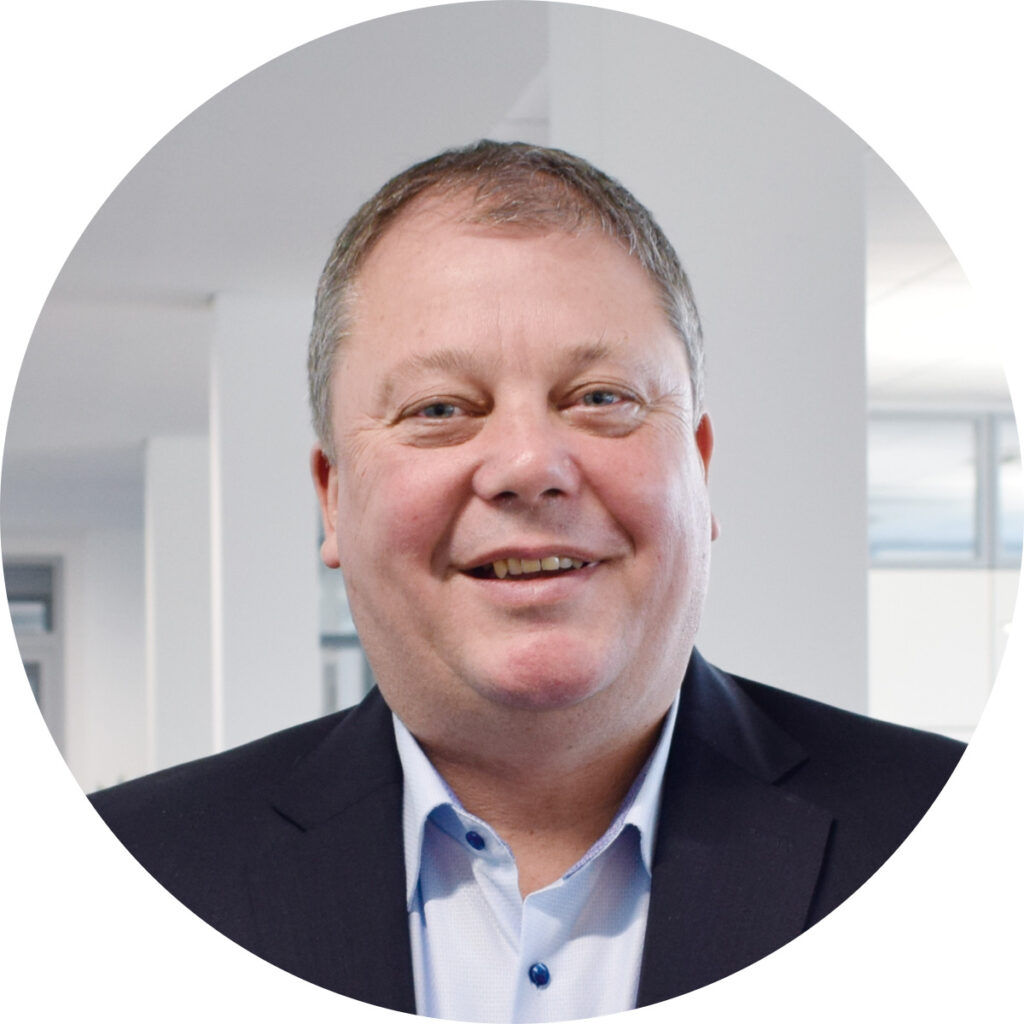
Interview with
Rolf Riedle
Rolf Riedle has been with Primetals Technologies and its predecessor companies for 28 years. He started his career in Saudi Arabia and spent six years in Malaysia working for Siemens. Later assignments took him to Australia and New Zealand. Together with his family, he then settled in Bavaria, a region in the south of Germany. Riedle is now CEO of Primetals Technologies Germany, which makes him responsible for three company locations, namely Erlangen, Willstätt-Legelshurst, and Saarbrücken.
What is it that makes the Erlangen location unique within Primetals Technologies?
Rolf Riedle: In Erlangen, the focus is on electrics and automation for the downstream. The contribution of the Erlangen location to the larger portfolio of Primetals Technologies is essential in my opinion.
How has the location developed over time?
Riedle: We have extended our business activities and our technological competence. New portfolio elements have been added, and we’ve further strengthened our efforts to provide steel producers with cutting-edge digital solutions to move closer toward “Industry 4.0.”
Are you serving steel producers worldwide or only in specific regions?
Riedle: We are operating globally, but we are structured to serve individual regions according to their particular needs. I believe that it is crucial to have a local presence to really understand and support any one part of the world. Much of our success is a result of us having built strong and market-specific local representations. We are incredibly close to our customers.
Is there any one aspect to steel production where you feel digital technologies should be adopted more comprehensively?
Riedle: The amount of production-related data is always increasing, and with the right technologies, their analysis can yield fantastic results. Today’s steel producers are under immense pressure to manufacture steel grades of higher and higher quality. Data-analysis tools can help them meet these challenges. Another thing that should be adopted more widely is robotics, because it makes plants a much safer workplace.
How will digitalization change our societies?
Riedle: That is the great debate: will robots soon replace human workers? Many jobs will clearly change, and it would be wrong to assume that it’s only the economy that will be affected by the transformation. Our education system will have to change to meet the new demands, and new ways of teaching and learning must be implemented to prepare us for the future.
Do you think the steel industry is in a relatively healthy state in 2019?
Riedle: No, I don’t. Viewed globally, we are still seeing significant overcapacity. Also, over the course of the last three years, we have noticed just how politics can impact the steel industry. The Chinese government, for instance, brought about a change in direction in the country, in terms of steel-production methods. Other major developments affect the U.S.A. and Mexico.
Is the outlook positive in your opinion?
Riedle: I think it is positive for the next two to three years. I would expect a slight downturn after that, with some consolidation in the industry. We live in a time of permanent change. The steel industry is still cyclical in nature, but the cycles have become shorter.
Two more quick questions: what invention do you feel should be made—but probably never will?
Riedle: The work that’s being done for the prevention and cure of illnesses is never enough.
Do you view artificial intelligence (AI) as a threat or as an opportunity?
Riedle: To me, the glass is always half full, so I take a positive view and see AI as a catalyst for progress.
